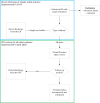Optimizing orthopedic trauma care delivery during the COVID-19 pandemic. A closed-loop audit of implementing a virtual fracture clinic and fast-track pathway in a Dutch level 2 trauma center
- PMID: 34632079
- PMCID: PMC8491002
- DOI: 10.1136/tsaco-2021-000691
Optimizing orthopedic trauma care delivery during the COVID-19 pandemic. A closed-loop audit of implementing a virtual fracture clinic and fast-track pathway in a Dutch level 2 trauma center
Abstract
Background: Guidelines concerning outpatient management of patients during the coronavirus pandemic required minimized face-to-face follow-up and increased remote care. In response, we established a virtual fracture clinic (VFC) review for emergency department (ED) patients with musculoskeletal injuries, meaning patients are reviewed 'virtually' the next workday by a multidisciplinary team, instead of routine referral for face-to-face fracture clinic review. Patients wait at home and are contacted afterwards to discuss treatment. Based on VFC review, patients with minor injuries are discharged, while for other patients an extensive treatment plan is documented using injury-specific care pathways. Additionally, we established an ED orthopedic trauma fast-track to reduce waiting time. This study aimed to evaluate the extent to which our workflow supported adherence to national coronavirus-related guidelines and effects on ED waiting time.
Methods: A closed-loop audit was performed during two 4-week periods using predefined standards: (1) all eligible ED orthopedic trauma patients are referred for VFC review; (2) reached afterwards; and follow-up is (3) patient initiated, or (4) performed remotely, whenever possible. Total ED waiting time, time to review, time for review, and time after review were assessed during both audit periods and compared with previous measurements.
Results: During both audits, the majority of eligible ED patients were referred for VFC review (1st: n=162 (88.0%); 2nd: n=302 (98.4%)), and reached afterwards (1st: 98.1%; 2nd: 99.0%). Of all referred patients, 17.9% and 13.6% were discharged 'virtually' during first and second audits, respectively, while 45.0% and 41.1% of scheduled follow-up appointments were remote. Median total ED waiting time was reduced (1st: -36 minutes (p<0.001); 2nd: -33 minutes (p<0.001)). During the second audit, median ED time to review was reduced by -13 minutes (p<0.001), as well as time for review: -10 minutes (p=0.019).
Discussion: In line with national guidelines, our VFC review allowed time-effective review and triage of the majority of ED orthopedic trauma patients, supporting patient-initiated and remote follow-up, whenever possible. ED waiting time was reduced after implementing the VFC review and orthopedic trauma fast-track.
Level of evidence: IV.
Keywords: COVID-19; bone; fractures; orthopedics; quality improvement.
© Author(s) (or their employer(s)) 2021. Re-use permitted under CC BY-NC. No commercial re-use. See rights and permissions. Published by BMJ.
Conflict of interest statement
Competing interests: None declared.
Figures



References
-
- World Health Organization . Coronavirus disease (COVID-19) pandemic. https://www.euro.who.int/en/health-topics/healthemergencies/coronavirus-....
-
- Federatie Medisch Specialisten . Handreiking voor keuzes bij het op- en afschalen van reguliere poliklinische non-COVID zorg ten tijde van schaarste in de COVID-19 pandemie. https://www.demedischspecialist.nl/sites/default/files/Handreiking%20op-....
-
- British Orthopaedic Assocation . Management of patients with urgent orthopaedic conditions and trauma during the coronavirus pandemic. https://www.boa.ac.uk/resources/covid-19-boasts-combined.html.
-
- Jenkins PJ. The glasgow fracture pathway: a virtual clinic. BJJ 2014;395:22–4http://www.fractureclinicredesign.org/wp-content/uploads/2013/09/BJJ-Art....
LinkOut - more resources
Full Text Sources
Research Materials
